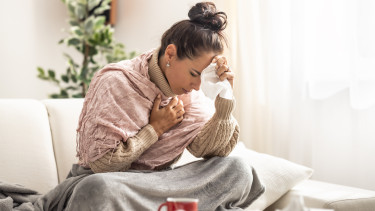Number of respiratory infections grows, hospitalisations drop in Hungary

The current respiratory season starts worse than in the previous years. The number of people seeking medical help with acute respiratory infection (ARI) was higher than in the previous two seasons but lower than in 2022/23. The number of influenza-like illness (ILI), however, was still higher on the 44th week than on the same week of the previous three years.
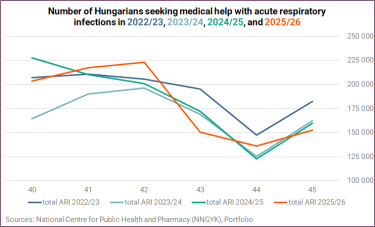
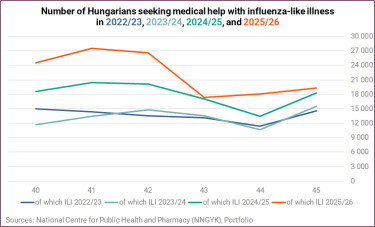
The share of ILI in ARI was 12.7%, also higher than in the previous three years, although down from 13.3% a week earlier.
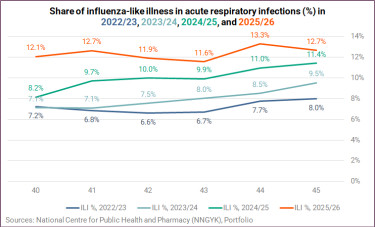
With regard to the number of ARI patients per 100,000 inhabitants, we were better off than in the previous three seasons.
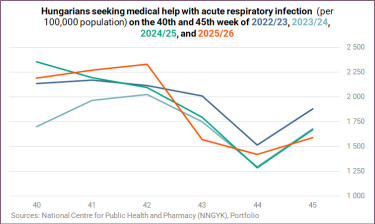
The number of patients with ILI per 100,000 people remained higher than the comparative figures of the previous three seasons.

In fact, this is the highest figure since 2011/2012.

The Covid-19 positivity rate came in at 23.9% when considering all positive tests (37) of the samples submitted by sentinel GPs (155) and at 27.8% when calculating with all positive tests (52) in all of the samples (i.e. those submitted by sentinel hospitals and also traditional diagnostic samples, 187 in total).
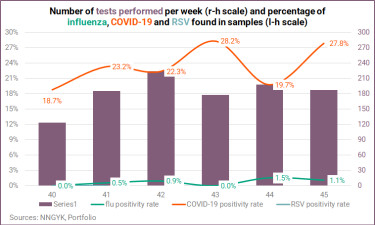
The coronavirus positivity rate was lower on the 45th week in all of the previous three seasons!

Hospitalisations
There were 75 people in hospital with severe acute respiratory infection (SARI), down sharply from 110 a week earlier, of whom 16 tested positive for COVID-19 (21.3%), which compares with 29.4% in 2024/25 and 71.5% in 2023/24, when hospitals admitted way more SARI patients on the 45th week, 126 and 158, respectively.
Four of the 75 patients needed intensive of subintensive care, a ratio of 5.3%, which compares with 13 in the same week of 2024 and 15 in 2023 (with ratios of 10.3% and 9.5%, respectively).
More than 60% of people admitted to hospital with a coronavirus infection were over 60 years old (10 in total), and half of SARI patients were in this age group (38 in total). A bit less than a quarter of SARI patients were under two years old (18 in total).
The NNGYK also had some key data published since the official end of the previous respiratory season on the 20th week, which show a general increase in the number of hospitalsed SARI patients since the 35th week, except for a surprise drop on the 42nd week. We also find that SARS-CoV-2 is the main reason behind hospitalisations.
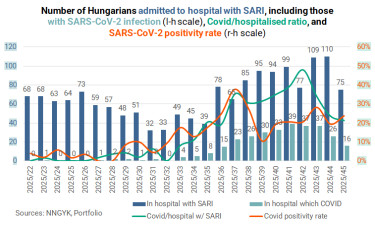
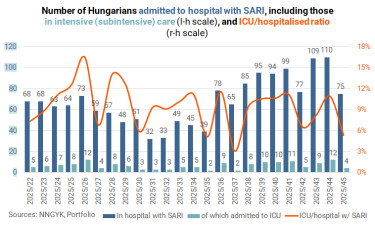
So far, this season is less serious than the previous ones when it comes to how many of all people with ARI end up in hospital. We were concerned a week ago that the orange line might be on its way to cross the blue (or green) ones, but it turned down instead.

The patterns of the previous years suggest that the ratio of coronavirus infections in hospitalisations should keep dropping and get close to 0-10% by the 5th or 6th week of next year. In parallel with this, influenza infections behind hospitalisations should start to pick up before the end of the year or early 2026. And then there's the respiratory syncytial virus (RSV) to consider.
This is how the pathogens 'swapped places' as the main reason behind hospitalisations last year.

And this is how they have been changed in the current and past three seasons of respiratory infections. (Note that the the RSV was not reported to be behind any hospitalisation until the 47th week in 2024 and the 49th week in 2023, and that's why you cannot find the orange line on that graph yet.)
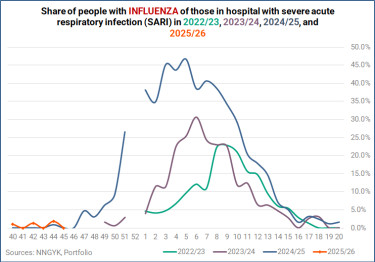


Age breakdown
Almost 39% (62,000) of people seeking medical help with an acute respiratory infection (ARI) in week 45 were children aged up to 14, up from around 46,400 or 37.7% a week earlier. More than a quarter (42,700) were aged 15–34.
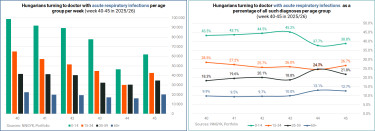
The graphs below show a breakdown of ARI patients by age group for this year and the previous two seasons.

When it comes to ILI, the most affected age group was people aged 15-34, accounting for about 6,500 (35.6%) of all patients with influenza-like illness, followed by the 35-59 age group (5,800 or 31.7%).

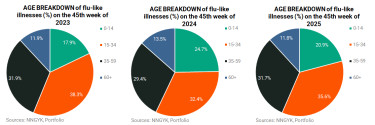
Cover image (for illustration purposes only): Portfolio




